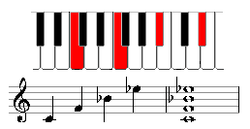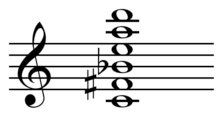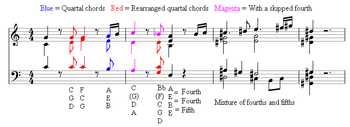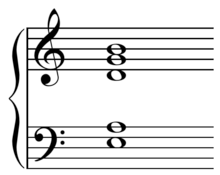Quartal and quintal harmony

In music, quartal harmony is the building of harmonic structures with a distinct preference for the intervals of the perfect fourth, the augmented fourth and the diminished fourth. Quintal harmony is harmonic structure preferring the perfect fifth, the augmented fifth and the diminished fifth.

Use of the terms quartal and quintal arises from a contrast, compositional or perceptual, with traditional tertian harmonic constructions. Listeners familiar with music of the (European) common practice period perceive tonal music as that which uses major and minor chords and scales, wherein both the major third and minor third constitute the basic structural elements of the harmony.
Quintal harmony (the harmonic layering of fifths specifically) is a lesser-used term, and since the fifth is the inversion or complement of the fourth, it is usually considered indistinct from quartal harmony. Indeed, a circle of fifths can be arranged in fourths (G→C→F→B♭ etc. are fifths when played downwards and fourths when played upwards); this is the reason that modern theoreticians may speak of a "circle of fourths".
History
In the Middle Ages, simultaneous notes a fourth apart were heard as a consonance. During the common practice period (between about 1600 and 1900), this interval came to be heard either as a dissonance (when appearing as a suspension requiring resolution in the voice leading) or as a consonance (when the tonic of the chord appears in parts higher than the fifth of the chord). In the later 19th century, during the breakdown of tonality in classical music, all intervallic relationships were once again reassessed. Quartal harmony was developed in the early 20th century as a result of this breakdown and reevaluation of tonality.
Precursors

The Tristan chord is made up of the notes F♮, B♮, D♯ and G♯ and is the very first chord heard in Wagner's opera Tristan und Isolde. The bottom two notes make up an augmented fourth; the upper two make up a perfect fourth. This layering of fourths in this context has been seen as highly significant. The chord had been found in earlier works (Vogel 1962, 12; Nattiez 1990, ) (notably Beethoven's Piano Sonata No. 18) but Wagner's use was significant, first because it is seen as moving away from traditional tonal harmony and even towards atonality, and second because with this chord Wagner actually provoked the sound or structure of musical harmony to become more predominant than its function, a notion which was soon after to be explored by Debussy and others (Erickson 1975, ). Beethoven's use of the chord is of short duration and it resolves in the accepted manner; whereas Wagner's use lasts much longer and resolves in a highly unorthodox manner for the time. Despite the layering of fourths, it is rare to find musicologists identifying this chord as "quartal harmony" or even as "proto-quartal harmony", since Wagner's musical language is still essentially built on thirds, and even an ordinary dominant seventh chord can be laid out as augmented fourth plus perfect fourth (F-B-D-G). Wagner's unusual chord is really a device to draw the listener into the musical-dramatic argument which the composer is presenting to us. However, fourths become important later in the opera, especially in the melodic development.
At the beginning of the 20th century, fourth-based chords finally became an important element of harmony.

Scriabin used a self-developed system of transposition using fourth-chords, like his Mystic chord in his Piano Sonata No. 6. Scriabin wrote this chord in his sketches alongside other quartal passages and more traditional tertian passages, often passing between systems, for example widening the six-note quartal sonority (C – F♯ – B♭ – E – A – D) into a seven-note chord (C – F♯ – B♭ – E – A – D – G).
Scriabin's sketches for his unfinished work Mysterium show that he intended to develop the Mystic chord into a huge chord incorporating all twelve notes of the chromatic scale (Morrison 1998, 316).

In France, Erik Satie experimented with planing in the stacked fourths (not all perfect) of his 1891 score for Le Fils des étoiles (Solomon 2003).
In the 1897 work Paul Dukas's The Sorcerer's Apprentice, we hear a rising repetition in fourths, as the tireless work of out-of-control walking brooms causes the water level in the house to "rise and rise". Quartal harmony in Ravel's Sonatine and Ma mère l'oye would follow a few years later.
20th- and 21st-century classical music
Composers who use the techniques of quartal harmony include Claude Debussy, Francis Poulenc, Alexander Scriabin, Alban Berg, Leonard Bernstein, Arnold Schoenberg, Igor Stravinsky, and Anton Webern (Herder 1987, 78).
Schoenberg
Arnold Schoenberg's Chamber Symphony Op. 9 (1906) displays quartal harmony: the first measures construct a five-part fourth chord with the notes C – F – B♭ – E♭ – A♭ distributed over several instruments. The composer then picks out this vertical quartal harmony in a horizontal sequence of fourths from the horns, eventually leading to a passage of triadic quartal harmony (i.e., chords of three notes, each layer a fourth apart).
Six-note horizontal fourth chord in Arnold Schoenberg's Chamber Symphony Op. 9 |
 Vertical quartal-harmony in the opening measures of Arnold Schoenberg's Chamber Symphony Op. 9 |
Schoenberg was also one of the first to write on the theoretical consequences of this harmonic innovation. In his Theory of Harmony (Harmonielehre) of 1911 he wrote: "The construction of chords by superimposing fourths can lead to a chord that contains all the twelve notes of the chromatic scale; hence, such construction does manifest a possibility for dealing systematically with those harmonic phenomena that already exist in the works of some of us: seven, eight, nine, ten, eleven, and twelve-part chords... But the quartal construction makes possible, as I said, accommodation of all phenomena of harmony" (Schoenberg 1978, 406–407).
Webern, Ives, and Bartók
For Anton Webern, the importance of quartal harmony lay in the possibility of building new sounds. After hearing Schoenberg's Chamber Symphony, Webern wrote "You must write something like that, too!" (Webern 1963, 48; "So was mußt du auch machen!")


Hindemith

Hindemith constructed large parts of his symphonic work Symphony: Mathis der Maler by means of fourth and fifth intervals. These steps are a restructuring of fourth chords (C – D – G becomes the fourth chord D – G – C), or other mixtures of fourths and fifths (D♯ – A♯ – D♯ – G♯ – C♯ in measure 3 of the example). Hindemith was, however, not a proponent of an explicit quartal harmony. In his 1937 writing Unterweisung im Tonsatz (The Craft of Musical Composition, Hindemith 1937), he wrote that "notes have a family of relationships, that are the bindings of tonality, in which the ranking of intervals is unambiguous," so much so, indeed, that in the art of triadic composition "...the musician is bound by this, as the painter to his primary colours, the architect to the three dimensions." He lined up the harmonic and melodic aspects of music in a row in which the octave ranks first, then the fifth and the third, and then the fourth. "The strongest and most unique harmonic interval after the octave is the fifth, the prettiest nevertheless is the third by right of the chordal effects of its Combination tones."

Others
In his Theory of Harmony (Schoenberg 1978, 407): "Besides myself my students Dr. Anton Webern and Alban Berg have written these harmonies (fourth chords), but also the Hungarian Béla Bartók or the Viennese Franz Schreker, who both go a similar way to Debussy, Dukas and perhaps also Puccini, are not far off."
The works of the Filipino composer Eliseo M. Pajaro (1915–1984) are characterised by quartal and quintal harmonies, as well as by dissonant counterpoint and polychords (Kasilag 2001).
As a transition to the history of jazz, George Gershwin may be mentioned. In the first movement of his Concerto in F altered fourth chords descend chromatically in the right hand with a chromatic scale leading upward in the left hand.
Jazz
The style of jazz, having an eclectic harmonic orbit, was in its early days overtaken (until perhaps the Swing of the 1930s) by the vocabulary of 19th-century European music. Important influences come thereby from opera, operetta, military bands as well as from the piano music of Classical and Romantic composers, and even that of the Impressionists. Jazz musicians had a clear interest in harmonic richness of colour, for which quartal harmony provided possibilities, as used by pianists and arrangers like Jelly Roll Morton, Duke Ellington, Art Tatum, Bill Evans (Hester 2000, 199) Milt Buckner (Hester 2000, 199) Chick Corea (Herder 1987, 78; Scivales 2005, 203) Herbie Hancock (Herder 1987, 78; Scivales 2005, 203) and especially McCoy Tyner (Herder 1987, 78; Scivales 2005, 205).


The hard bop of the 1950s made new applications of quartal harmony accessible to jazz. Quintet writing in which two brass instruments (commonly trumpet and saxophone) may proceed in fourths, while the piano (as a uniquely harmonic instrument) lays down chords, but sparsely, only hinting at the intended harmony. This style of writing, in contrast with that of the previous decade, preferred a moderate tempo. Thin-sounding unison bebop horn sections occur frequently, but these are balanced by bouts of very refined polyphony such as is found in cool jazz.

On his watershed record Kind of Blue, Miles Davis with pianist Bill Evans used a chord consisting of three perfect fourth intervals and a major third on the composition "So What". This particular voicing is sometimes referred to as a So What chord, and can be analyzed (without regard for added sixths, ninths, etc.) as a minor seventh with the root on the bottom, or as a major seventh with the third on the bottom (Levine 1989, 97).
From the outset of the 1960s, the employment of quartal possibilities had become so familiar that the musician now felt the fourth chord existed as a separate entity, self standing and free of any need to resolve. The pioneering of quartal writing in later jazz and rock, like the pianist McCoy Tyner's work with saxophonist John Coltrane's "classic quartet", was influential throughout this epoch. Oliver Nelson was also known for his use of fourth chord voicings (Corozine 2002, 12). Floyd claims that the "foundation of 'modern quartal harmony'" began in the era when the Charlie Parker–influenced John Coltrane added classically trained pianists Bill Evans and McCoy Tyner to his ensemble (Floyd 2004, 4).
Jazz guitarists cited as using chord voicings using quartal harmony include Johnny Smith, Tal Farlow, Chuck Wayne, Barney Kessel, Joe Pass, Jimmy Raney, Wes Montgomery, however all in a traditional manner, as major 9th, 13th and minor 11th chords (Floyd 2004, 4) (an octave and fourth equals an 11th). Jazz guitarists cited as using modern quartal harmony include Jim Hall (especially Sonny Rollins's The Bridge), George Benson ("Skydive"), Pat Martino, Jack Wilkins ("Windows"), Joe Diorio, Howard Roberts ("Impressions"), Kenny Burrell ("So What"), Wes Montgomery ("Little Sunflower"), Henry Johnson, Russell Malone, Jimmy Bruno, Howard Alden, Paul Bollenback, Mark Whitfield, and Rodney Jones (Floyd 2004, 4).
Quartal harmony was also explored as a possibility under new experimental scale models as they were "discovered" by jazz. Musicians began to work extensively with the so-called church modes of old European music, and they became firmly situated in their compositional process. Jazz was well-suited to incorporate the medieval use of fourths to thicken lines into its improvisation. The pianists Herbie Hancock, and Chick Corea are two musicians well known for their modal experimentation. Around this time, a style known as free jazz also came into being, in which quartal harmony had extensive use due to the wandering nature of its harmony.

In jazz, the way chords were built from a scale came to be called voicing, and specifically quartal harmony was referred to as fourth voicing.

Thus when the m11 and the dominant 7th sus (9sus above) chords in quartal voicings are used together they tend to "blend into one overall sound" sometimes referred to as modal voicings, and both may be applied where the m11 chord is called for during extended periods such as the entire chorus (Boyd 1997, 95).
Rock music

Quartal and quintal harmony have been used by Robert Fripp, who has described himself as the rhythm guitarist of King Crimson. Fripp dislikes minor thirds and especially major thirds in equal temperament tuning, which is used by non-experimental guitars. Of course, just intonation's perfect octaves, perfect fifths, and perfect fourths are well approximated in equal temperament tuning, and perfect fifths and octaves are highly consonant intervals. Fripp builds chords using perfect fifths, fourths, and octaves in his new standard tuning (NST), a regular tuning having perfect fifths between its successive open-strings (Mulhern 1986, ).
Tarkus by Emerson, Lake & Palmer uses quartal harmony (Macon 1997, 55).
Examples of quartal pieces
Classical
- Sonata for Alto Saxophone and Piano (Lewis 1985, 443)
- Sonata for Piano, op. 1 (Lambert 1996, 118)
- Wozzeck (Lambert 1996, 118; Reisberg 1975, 344–46)
- Sinfonía de Antígona (Symphony No. 1), uses quartal harmony throughout (Orbón 1987, 83)
- Sinfonía india (Symphony No. 2), the A-minor Sonora melody beginning in b. 183 is accompanied by quartal harmonies (Leyva 2010, 56)
- Of Mice and Men (Bick 2005, 446, 448, 451)

- "La cathédrale engloutie", beginning and ending (Reisberg 1975, 343–44)
- Suite for Piano
- Piano Sonata No. 7 (Kroeger 1969)
- 12 American Preludes, Prelude #7
- "Donde habite el olvido" (Kulp 2006, 207)
- Bacchanalia for Band (Spieth 1978)
- "The Cage" (1906) (Carr 1989, 135; Lambert 1990, 44; Lambert 1996, 118; Murphy 2008, 179, 181, 183, 185–86, 190–91; Reisberg 1975, 344–45; Scott 1994, 458)
- Central Park in the Dark (Scott 1994, 458)
- "Harpalus" (Scott 1994, 458)
- Psalm 24, verse 5 (Lambert 1990, 67; Scott 1994, 458)
- Psalm 90 (Scott 1994, 458)
- "Walking" (Scott 1994, 458)
- String Quartet No. 2, Adagio (Cowell 1956, 243)
- Sonatina for flute & piano, Op. 76 (Cardew-Fanning n.d.)
- Clarinet Concerto (Archibald 1969, 825)
- Ricercare for Orchestra (Archibald 1969, 825)
- Ma mère l'oye : "Mouvt de Marche" of "Laideronnette" (Murphy, Melcher, and Warch 1973, )
- King Midas, cantata (Sjoerdsma 1972)
- The Book of the Hanging Gardens (Domek 1979, 112–13, 117)
- Chamber Symphony, Op. 9 (Reisberg 1975, 344–45; Sanderson n.d.), slow section (Rubin 2005), b. 1–3 (Lambert 1990, 68)
- Wind Quintet, op. 26 (Corson and Christensen 1984)
- Diatonic Study (1914) (Stein 1979, 18)
- Suite No. 3 for Piano (Dickinson 1963)
- Piano Sonata (Swayne 2002, 285–87, 290)
- Klavierstück IX (Reisberg 1975, 349–50)
- "Saw a Grave" (Moe 1981–82, 70)
- Variations for Piano, Op. 27 (Reisberg 1975, 348)
Jazz
Folk
On her 1968 debut album Song to a Seagull, Joni Mitchell used quartal and quintal harmony in "Dawntreader", and she used quintal harmony in Seagull (Whitesell 2008, 131 and 202–203).
Rock
- Emerson, Lake & Palmer
- Tarkus (Macon 1997, p. 55)
- Frank Zappa
- "Zoot Allures" (Mermikides 2014, 31)
- XTC
- "Rook" (composed by Andy Partridge, from the album Nonsuch) (Anon. n.d.)
See also
References
- Anon. (n.d.). "Rook", ChalkHills.org. Analysis and guitar tab.
- Archibald, Bruce (1969). "Variations for Cello and Orchestra (1966) by Walter Piston; Concerto for Clarinet and Orchestra (1967) by Walter Piston; Ricercare for Orchestra (1967) by Walter Piston". Notes, second series 25, no. 4 (June): 824–26.
- Benward, Bruce, and Nadine Saker (2009). Music in Theory and Practice, Vol. II. ISBN 978-0-07-310188-0.
- Bick, Sally (2005). "Of Mice and Men: Copland, Hollywood, and American Musical Modernism". American Music 23, no. 4 (Winter): 426–72.
- Boyd, Bill (1997). Jazz Chord Progressions. ISBN 0-7935-7038-7.
- Cardew-Fanning, Neil (n.d.). "Sonatina for flute & piano, Op. 76", AllMusic.com.
- Carpenter, Alexander (n.d.). "Le fils des étoiles, Chaldean pastoral, 3 preludes for piano", AllMusic.com.
- Carr, Cassandra I. (1989). "Charles Ives’s Humor as Reflected in His Songs". American Music 7, no. 2 (Summer): 123–39.
- Corozine, Vince (2002). Arranging Music for the Real World: Classical and Commercial Aspects. Pacific, MO: Mel Bay. ISBN 0-7866-4961-5. OCLC 50470629.
- Corson, Langdon, and Roy Christensen (1984). Arnold Schoenberg's Woodwind Quintet, op. 26: Background and Analysis. Nashville: Gasparo Co.
- Cowell, Henry (1956). "Current Chronicle: United States: New York" The Musical Quarterly 42, no. 2 (April): 240–44.
- Dickinson, Peter (1963). "Suite for Piano No 3 by Nikos Skalkottas". The Musical Times 104, no. 1443 (May): 357.
- Domek, Richard C. (1979). "Some Aspects of Organization in Schoenberg's Book of the Hanging Gardens, opus 15". College Music Symposium 19, no. 2 (Fall): 111–28.
- Erickson, Robert (1975). Sound Structure in Music. Oakland, California: University of California Press. ISBN 0-520-02376-5.
- Floyd, Tom (2004). Quartal Harmony & Voicings for Guitar. ISBN 0-7866-6811-3.
- Herder, Ronald (1987). 1000 Keyboard Ideas. ISBN 0-943748-48-8.
- Hindemith, Paul (1937). Unterweisung im Tonsatz. 1.
- Hester, Karlton E. (2000). From Africa to Afrocentric Innovations Some Call "Jazz": The Creation of Free, Fusion and Reconstructive Modern Styles (1950–2000). ISBN 1-58684-054-1.
- Josh (2010) "4th Chords and Quartal Harmony". FretterVerse.com (30 June, accessed 6 September 2014).
- Kasilag, Lucrecia R. (2001). "Pajaro, Eliseo (Morales)". The New Grove Dictionary of Music and Musicians, second edition, edited by Stanley Sadie and John Tyrrell. London: Macmillan Publishers.
- Kostka, Stefan, Dorothy Payne, and Byron Almén (2013). Tonal Harmony with an Introduction to Twentieth-Century Music (seventh ed.). New York: McGraw-Hill. pp. 38–53. ISBN 978-0-07-131828-0.
- Kroeger, Karl (1969). "Caspar Diethelm: Klaviersonate VII". Notes, second series 26, no. 2 (December): 363.
- Kulp, Jonathan (2006). "Carlos Guastavino: A Re-Evaluation of His Harmonic Language". Latin American Music Review / Revista de Música Latinoamericana 27, no. 2 (Autumn-Winter): 196–219.
- Lambert, J. Philip (1990). "Interval Cycles as Compositional Resources in the Music of Charles Ives". Music Theory Spectrum 12, no. 1 (Spring): 43–82.
- Lambert, J. Phillip (1996). "Ives and Berg: 'Normative' Procedures and Post-Tonal Alternatives". In Charles Ives and the Classical Tradition, edited by Geoffrey Block and J. Peter Burkholder, 105–30. New Haven: Yale University Press.
- Levine, Mark (1989). The Jazz Piano Book. Petaluma, CA: Sher Music Co. ISBN 0-9614701-5-1.
- Lewis, Robert Hall (1985). "New Music Festival 1985: Bowling Green State University". Perspectives of New Music 24, no. 1 (Fall–Winter): 440–43.
- Leyva, Jesse (2010). "Carlos Chávez: An Examination of His Compositional Style with a Conductor’s Analysis of Sinfonía India as Arranged for Concert Band by Frank Erickson". DMA diss. Tempe: Arizona State University.
- Macon, Edward L (1997). Rocking the Classics: English Progressive Rock and the Counterculture. Oxford and New York: Oxford University Press. ISBN 0-19-509887-0..
- Mermikides, Milton (2014). "Extreme Guitar". Guitar Techniques magazine, Issue 230.
- Moe, Orin (1981–82). "The Songs of Howard Swanson". Black Music Research Journal 2:57–71.
- Morrison, S. (1998). "Skryabin and the Impossible". Journal of the American Musicological Society 51, no. 2.
- Mulhern, Tom (1986). "On the Discipline of Craft and Art: An Interview with Robert Fripp". Guitar Player 20 (January): 88–103 (accessed 8 January 2013).
- Murphy, Scott (2008). "A Composite Approach to Ives’s 'Cage'". Twentieth-Century Music 5:179–93.
- Murphy, Howard Ansley, Robert A. Melcher, and Willard F. Warch, eds. (1973). Music for Study: A Source Book of Excerpts, second edition. Englewood Cliffs, NJ: Prentice-Hall. ISBN 0-13-607515-0.
- Nattiez, Jean-Jacques (1990). Music and Discourse: Toward a Semiology of Music, translated by Carolyn Abbate. Princeton, N.J.: Princeton University Press. ISBN 0-691-02714-5.
- Orbón, Julián (1987). "Las sinfonías de Carlos Chávez." (part 2). Pauta: Cuadernos de teoría y crítica musical 6, no. 22 (April–June): 81–91.
- Perone, James E. (1993). Howard Hanson: A Bio-Bibliography. Westport and London: Greenwood Press.
- Reisberg, Horace (1975). "The Vertical Dimension in Twentieth-Century Music". In Aspects of 20th Century Music, Gary E. Wittlich, coordinating editor, 322–87. Englewood Cliffs, NJ: Prentice-Hall. ISBN 0-13-049346-5.
- Rubin, Justin Henry (2005). "Quartal Harmony". University of Minnesota Duluth website d.umn.edu (accessed 26 April 2012).
- Sanderson, Blair (n.d.). "Arnold Schoenberg: Verklärte Nacht; Chamber Symphony; Variations; 5 Pieces; 6 Songs; Erwartung", AllMusic.com.
- Schoenberg, Arnold (1922). Harmonielehre (third ed.). Vienna: universal edition.
- Schoenberg, Arnold (1978). Theory of Harmony. translated by Roy E. Carter, based on the third edition (1922). Berkeley and Los Angeles: University of California Press. ISBN 0-520-04945-4 (cloth); ISBN 0-520-04944-6 (pbk).
- Scivales, Ricardo (2005). Jazz Piano—The Left Hand. ISBN 1-929009-54-2..
- Scott, Ann Besser (1994). "Medieval and Renaissance Techniques in the Music of Charles Ives: Horatio at the Bridge?" The Musical Quarterly 78, no. 3 (Autumn): 448–78.
- Sjoerdsma, Richard Dale (1972). "King Midas; A Cantata for Voices and Piano on 10 Poems of Howard Moss by Ned Rorem". Notes, second series 28, no. 4 (June): 782.
- Solomon, Larry J. 2003. "Satie, the First Modern". Solomonsmusic.net (accessed 18 March 2016).
- Spieth, Donald (1978). "Bacchanalia for Band by Walter S. Hartley". Notes, second series 34, no. 4 (June): 974.
- Stein, Leon (1979). Structure & Style: The Study and Analysis of Musical Forms, second expanded edition. Princeton, N.J.: Summy-Birchard Music. ISBN 978-0-87487-164-7.
- Swayne, Steve (2002). "Sondheim's Piano Sonata". Journal of the Royal Musical Association 127, no. 2:258–304.
- Vogel, Martin (1962). Der Tristan-Akkord und die Krise der modernen Harmonielehre
- Webern, Anton (1963). The Path to the New Music,. edited by Willi Reich, translated by Leo Black. Bryn Mawr: Theodore Presser, in association with Universal Edition.
- Whitesell, Lloyd (2008). The Music of Joni Mitchell. Oxford and New York: Oxford University Press. ISBN 978-0-19-530757-3.
Further reading
- Baker, David N. (1983). Jazz Improvisation. Bloomington: Frangipani. ISBN 0-89917-397-7.
- Floirat, Bernard (2015). Introduction aux accords de quartes chez Arnold Schoenberg, Paris, www.academia.edu.
- Persichetti, Vincent (1961). Twentieth-century Harmony: Creative Aspects and Practice. New York: W. W. Norton. ISBN 0-393-09539-8. OCLC 398434.
- Rosenthal, David H. (1993). Hard Bop, Jazz and Black Music 1955–1965. New York: Oxford University Press. ISBN 0-19-508556-6.
External links
- Quartalharmony with notes and listening examples
- Quartal voicing for the guitar
- Program notes for Arnold Schoenberg's Chamber Symphony for 15 Solo Instruments op. 9